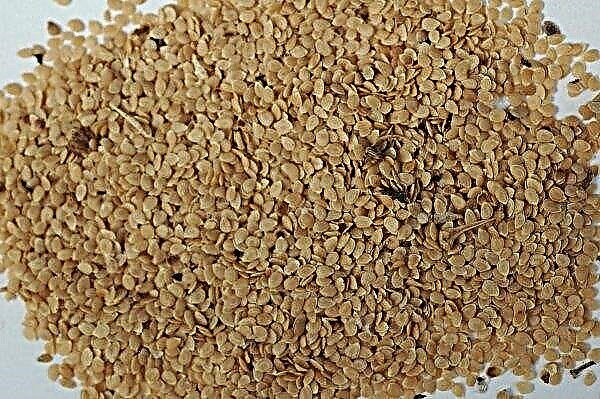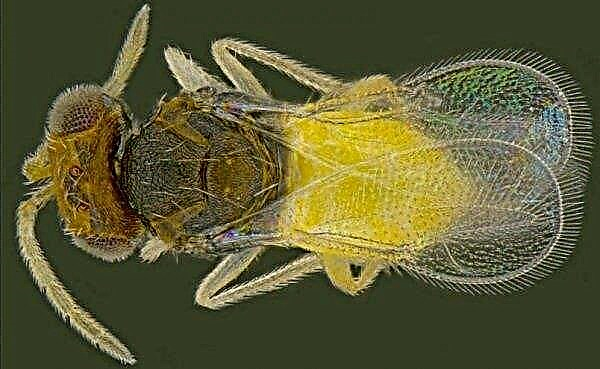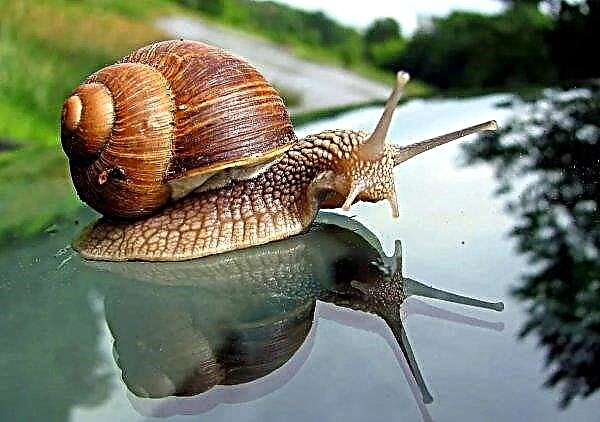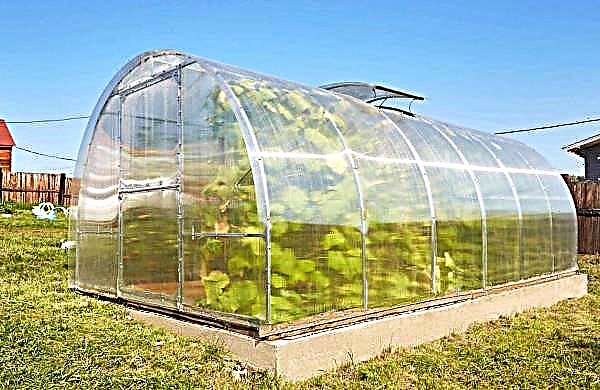In the world there are a large number of breeds that are very difficult to calculate. However, among this large variety stands out such a breed as Leghorn, which is one of the best laying hens. This article will help you learn a lot more about Leghorn chickens and their content.
History of breed origin
Leghorn chickens were bred in the 19th century by Spanish breeders. They got their name in honor of the port city of Livorno. However, due to low productivity and poor adaptation, the breed did not receive special popularity. Despite this, leggorn chickens were exported to England, and then to the United States. These birds attracted the attention of American breeders, who later by crossing with different breeds could significantly increase productivity.
Did you know? In 1979, a test at the University of Missouri College of Agriculture set a record for laying eggs among leggors. The white leggorn laying hens laid 371 eggs, which is 7 more than the previous record.
After analyzing the results of their work, poultry farmers came to the conclusion that the Spanish breed has great potential and already in 1874 the first data of this breed were recorded. From that moment, the standard was revised several times and made additions and amendments. At the end of the 19th century, an improved version of leggorn chickens began to be exported from the USA to Europe. At the beginning of the XX century, it was well distributed.
Many European breeders continued to improve this species, and as a result a large number of different subtypes appeared. In addition, they were used as genetic material to increase the productivity of many local breeds and breed new species. Leghors were brought into the Soviet Union only in the 1920s. Only a small percentage of the total poultry production fell on the breeding of this breed. The situation changed in the 60s, when there was worldwide demand for poultry.During this period, an innovative breeding system was introduced, which allowed for a short period of time to increase the production of leggorn chickens. However, not only the USSR was actively engaged in the production of this breed. The global growth of the poultry industry is associated precisely with the Leghorn chickens, who became the founders of many crosses in many countries around the world.
Description
Due to the sufficiently large age of this breed and the numerous experiments of breeders around the world, there are no clear standards for leggorn. In addition, in the 20th century, many regional varieties were bred, which led to the formation in each country of its own standard of the Leghorn breed, which is based on in-breed subtypes.
The most popular subspecies of leggorns in the world:
- white is the most common variety. They are often grown in the northern and southern latitudes, as they adapt well and are not whimsical to the conditions of detention and nutrition. In addition, they are able to rush for more than 200 days annually, for which they are appreciated by poultry farmers. Biological material of this variety was used to breed other breeds;
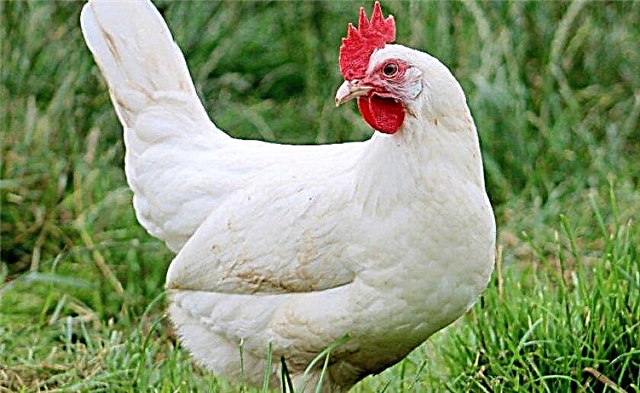
- brown - This subspecies is often called Italian partridge chickens. They, like white leghorns, are egg-bearing species, however, in these feathered males and females differ significantly in their plumage. The males are quite bright - a golden neck and a large spreading tail, and the females look dull against the background of the males;

- grouse - males of this species of leggorn have a light shade neck, black tail and brown back. Their plumage has inclusions of white and silver color, which create a mottled color. Females have brown breasts, and the back and tail are black. The plumage has a smooth transition from brown to black; there are inclusions only in the area of the wings and withers. Females rush well, but the size of the egg is smaller than that of other subspecies;

- goldenth - appreciated for its decorative appearance and high performance. One layer is able to lay about 265 eggs per year;
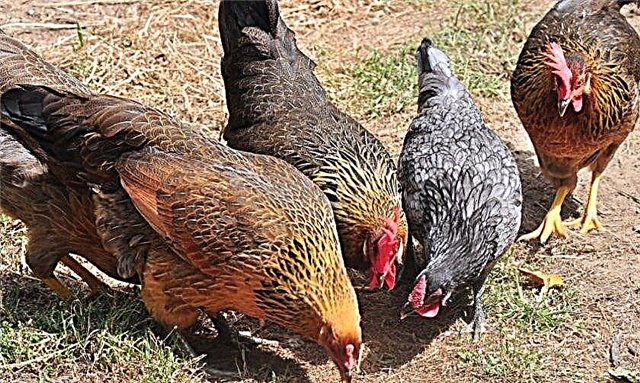
- spotted - the representatives of this subspecies plumage has a rare black and white color, for which they received the second name Dalmatians. This type of leggorn was bred in 1904 and gained popularity very quickly, because in addition to the unusual coloring, their egg-laying rates are at a fairly high level;
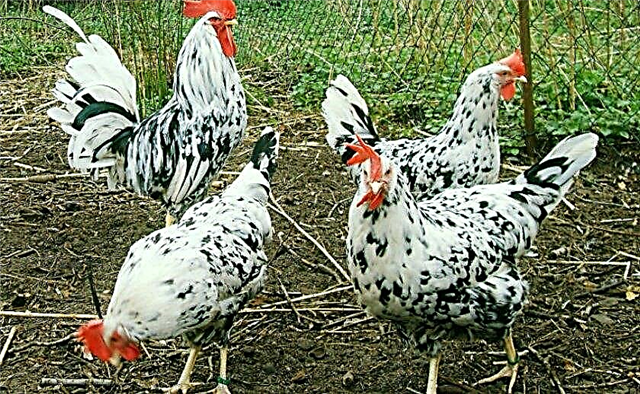
- dwarf - very often they are called mini. They are in no way inferior to their adult relatives, however, they consume about 40% less feed and need a small space for keeping, which makes them quite popular among poultry farmers.

Appearance characteristic
In our region, the most popular are the white leghors, which are often used in household households. However, in Russia there are more than 20 specialized poultry farms that are engaged in the cultivation of this breed exclusively. The appearance of roosters and hens is somewhat different. The most striking feature that is characteristic of all varieties is the crest. In roosters it stands straight, and in laying hens hangs.
The appearance of these birds is quite compact, since they have a small wedge-shaped body, which gracefully rises above the ground. The head is proportional to the body. Blue or white earlobes are clearly visible on it. The iris of the eyes can be dark orange or pale yellow; its color depends on the age of the birds. Chicken earrings are large and have a bright red hue. The neck of these birds smoothly bends. Leghorn have a large rounded chest and a wide, flat back. The chest is pushed forward and smoothly passes into a wide belly. The wings of birds are small and fit snugly to the body. In leghorns, the tail is inclined to the body at an angle of 35–40 °. Most often they show off only roosters, since laying hens are often lowered down. The legs of the hens are thin, of medium length. In young individuals, they are yellow, and whiten with age. However, the metatarsus is bright yellow or wheat yellow. The plumage is dense. Although the most common is white, brown or black and white, black, silver and even blue shades can be found, because Leghorns have more than 20 different variations.
In leghorns, the tail is inclined to the body at an angle of 35–40 °. Most often they show off only roosters, since laying hens are often lowered down. The legs of the hens are thin, of medium length. In young individuals, they are yellow, and whiten with age. However, the metatarsus is bright yellow or wheat yellow. The plumage is dense. Although the most common is white, brown or black and white, black, silver and even blue shades can be found, because Leghorns have more than 20 different variations.
Description of appearance:
| Head | medium sized |
| Crest | leaf-shaped, red |
| Beak | strong, short, yellow |
| Neck | long, thin, slightly curved |
| Chest | round, wide and forward |
| Stomach | wide |
| Wings | small, tight to the body |
| Tail | wide, slightly tilted |
| Paws | medium length, thin |
| Plumage and color | dense, more than 20 colors |
Productive qualities
For two centuries of breeding, the productivity of this species has been significantly increased. Breeders tried to increase early maturity and egg production. As a result, they were able to achieve maturation in 4–4.5 months. Hens begin to hatch already in 4.5–5 months and in a year they are able to lay 300–350 eggs. For different regions, this indicator can fluctuate, so the average value is often indicated by 220–240 eggs per year. The weight of the egg varies depending on the subspecies of Leghorn and is 55–58 g. However, in some crosses the weight of the egg can reach 65 g. In addition, depending on the variety of cross, there may be a different shell color. Often this shell has a white shell, but since there is a great demand for brown eggs in the world, crosses were bred for which such a shell is characteristic. For breeders, indicators such as the percentage of fertilized eggs and hatchability of young animals are very important. If you take 100 eggs, then there will be no more than 95 pieces fertilized from them. And no more than 87 chickens hatch from these, as the hatching percentage does not exceed 87–92%. Unfortunately, the difficulties do not end there, because of the Leghorn mothers are very bad, because they have no maternal instinct.
Often this shell has a white shell, but since there is a great demand for brown eggs in the world, crosses were bred for which such a shell is characteristic. For breeders, indicators such as the percentage of fertilized eggs and hatchability of young animals are very important. If you take 100 eggs, then there will be no more than 95 pieces fertilized from them. And no more than 87 chickens hatch from these, as the hatching percentage does not exceed 87–92%. Unfortunately, the difficulties do not end there, because of the Leghorn mothers are very bad, because they have no maternal instinct.
Did you know? A laying hen of the Leghorn breed in 1956 laid a 454 g weight egg, which had a double shell and two yolks.
Therefore, for effective excretion, it is best to use incubators. And in those rare cases when laying hens show a brood instinct, producers try to get rid of such individuals right away. It is important for poultry farmers to know the weight of live chicken and rooster, as well as the yield and quality of meat. Leghorns, like egg breeds, are characterized by small dimensions: a rooster - not more than 3 kg, a laying hen - up to 2 kg. When slaughtering these birds, the yield is very small and therefore they can be used only as a soup set, well, no matter how for the fillet. In addition, their meat is hard, coarse and tasteless, and also dry.
Character
This breed is characterized by peaceful calm temperament, however, it has increased activity. Free walking is more optimal for them than the cellular content. If you decide to keep the leggorn in the fence, then you should think about a net that will not allow birds to fly up and protect it from birds of prey. Although these chickens are unpretentious in keeping, this should not be abused, since under unfavorable conditions the birds are prone to peeling.
Although these chickens are unpretentious in keeping, this should not be abused, since under unfavorable conditions the birds are prone to peeling.
Advantages and disadvantages
- pros
- rapid puberty (4–4.5 months);
- start to lay eggs early (at 4.5–5 months);
- increased egg production (up to 300 eggs);
- easily adaptable and at the same time quite unpretentious to the conditions of detention;
- have a calm and complaisant character;
- tolerate negative temperatures well;
- high rates of hatchability of young animals;
- low feed costs;
- attractive appearance.
- Minuses
- a sharp decrease in egg production in the second year of life;
- lack of brooding instinct;
- low meat yield.
How to keep Leggorn breed?
Although these birds are undemanding to the conditions of their content, they should not be neglected. After all, proper care will significantly increase the effectiveness of the bird. So, let's figure out where and under what conditions it is necessary to contain the Leghorn breed.
Important! Leghorn chickens can be kept in cages, which will be quite spacious. This content is most often used in industry.
Arrangement of a chicken coop
According to many poultry farmers, special conditions are not required for this breed of chickens, the main thing is that they are protected from loud sounds and bright light, which can cause stress in birds. As a chicken coop, even a barn or other non-residential premises can come up. The room for this breed should be spacious enough, since the cramped space can cause the disease of birds. A good adaptation allows you to easily transfer both winter in the southern regions and in the northern ones. When arranging the place of detention, special attention should be paid to the absence of drafts, and also to prevent sudden jumps and lowering the temperature of less than + 5ºС. To eliminate drafts and maintain a temperate climate in the chicken coop, insulation of walls and ceilings will help. The use of high-quality insulating material will significantly save on heating.
A good adaptation allows you to easily transfer both winter in the southern regions and in the northern ones. When arranging the place of detention, special attention should be paid to the absence of drafts, and also to prevent sudden jumps and lowering the temperature of less than + 5ºС. To eliminate drafts and maintain a temperate climate in the chicken coop, insulation of walls and ceilings will help. The use of high-quality insulating material will significantly save on heating.
If the walls and ceiling can be sheathed, then thick litter must be used to insulate the floor. For this, straw, sawdust or hay is suitable. The thickness of such a flooring should be at least 50 cm. This will protect the herd from various diseases and maintain high egg production. In winter, it will become a good protection against the cold. As an overnight stay for chickens, it is necessary to equip reliable and convenient perches, which can be easily grasped.
To do this, the wooden base is turned round, and the diameter is selected in accordance with the circumference of the paws. The poles are fixed at a height of 80 cm from the floor. Choose the side opposite from the window. On the same side, only slightly lower are the nests. In addition, it is necessary to monitor air quality, it should be moderately dry and moist. The minimum permissible value of air humidity should not be less than 45%, and the maximum - more than 65%. A humid climate for the chicken coop becomes a favorable environment for the development of pathogens. Also, do not forget about cleanliness. It is necessary to clean the chicken coop regularly so that the feathers of the leggorn remain always clean. To do this, once a few days carry out the cleaning of perches and nests. Once every 14 days, the old litter is removed and replaced with a new one, however many poultry farmers replace the litter as necessary. And once a quarter they carry out a complete disinfection of the premises and general cleaning of the premises. Do not forget about the place of walking.
Also, do not forget about cleanliness. It is necessary to clean the chicken coop regularly so that the feathers of the leggorn remain always clean. To do this, once a few days carry out the cleaning of perches and nests. Once every 14 days, the old litter is removed and replaced with a new one, however many poultry farmers replace the litter as necessary. And once a quarter they carry out a complete disinfection of the premises and general cleaning of the premises. Do not forget about the place of walking.
For its arrangement, an open area is best suited, which will be reliably protected not only from various predatory animals, but also from birds. It is also worth remembering that the light weight of the leghorns makes it easy to overcome obstacles 1.5 meters high. The presence of green spaces in the walking area will positively affect the health of birds. This will allow you to replenish nutrient reserves during a walk. Do not forget that birds like to swarm, so it is worth considering the presence of ash baths and sand.
Important! During the period of active egg laying, it is necessary to minimize the noise background, since the birds are very sensitive to loud noises.
Nest arrangement
The arrangement of the nest is important for this breed, because egg laying depends on it. The nests must be placed at a certain distance from the ground so that cold air does not fall on the hens. The number of nests is determined by the number of laying hens in the chicken coop, so one nest will be enough for several chickens. As a litter, a thick layer of hay or grass grass is laid in the nest, which is periodically replaced as it becomes dirty and tamped.
Feeding troughs and drinking bowls
Do not forget about drinking bowls and feeders, the designs of which are also important. For birds, there is no particular significance from what to drink or eat, the main thing is that their quantity and contents in them are sufficient for all individuals. However, poultry farmers need to know that there are certain requirements for these elements of the chicken coop.
The requirements for feeders for all types of chickens are the same:
- the design of the feeder should not allow birds to climb into it and scatter the feed, as well as protect its contents from ingestion of excrement;
- practical to use (there are no problems with filling, during washing, light weight, which makes it easy to move);
- optimal dimensions that allow you to eat the whole livestock at the same time.
Drinker Requirements:
- the design of the drinking bowl should be convenient for both hens and poultry farmers;
- easy to wash and fill;
- Do not tip over;
- the probability of ingestion or reproduction of pathogens is excluded;
- must be safe for birds: without sharp edges, without the release of chemicals.
 As drinkers, you can use both nipple drinkers, and home-made drinkers from plastic bottles, vacuum or even open containers. The first version of drinking bowls is the best option for the industrial cultivation of leghorns, however, in private households they have been very popular lately.
As drinkers, you can use both nipple drinkers, and home-made drinkers from plastic bottles, vacuum or even open containers. The first version of drinking bowls is the best option for the industrial cultivation of leghorns, however, in private households they have been very popular lately.Did you know? For normal life, one chicken needs to drink at least 0.5 liters of water per day.
Ventilation and lighting
The air in the chicken coop should not stagnate, so it must be updated regularly. The room should be regularly ventilated so that the birds do not get poisoned as a result of exposure to ammonia or other harmful substances that are released during decay of the litter. To organize a chicken coop, a ventilation system should be provided.
However, it must be remembered that it must meet certain requirements:
- the ventilation system controls the rate of air renewal in the room;
- removes vapors of ammonia and other vapors;
- allows you to control the temperature in the room.
In winter, when it is cold enough outside, fresh air should be dosed, as there is a possibility of overcooling the chicken coop. For this, an automated air supply system is used during installation, and the supply channels are equipped with grills with adjustable openings. However, if leghorns are kept in a small chicken coop, then there will be enough natural ventilation, that is, regular ventilation 2 times a day. The chicken coop needs additional lighting. Not only the health of birds depends on it, but also their productivity. In the absence of light, the probability of injury to chickens increases, and the aggressiveness of birds increases. For normal life, daylight hours of birds should be at least 8-10 hours, and a day duration of 12 hours will increase egg production by 30%. The need for an additional light source arises in winter, when it grows late and gets dark early.
Not only the health of birds depends on it, but also their productivity. In the absence of light, the probability of injury to chickens increases, and the aggressiveness of birds increases. For normal life, daylight hours of birds should be at least 8-10 hours, and a day duration of 12 hours will increase egg production by 30%. The need for an additional light source arises in winter, when it grows late and gets dark early.
When organizing lighting in the chicken coop, remember:
- daylight hours depend on the age of the birds;
- the type of light is also taken into account: the use of red-orange lighting has a positive effect on reproductive properties, but the yellow spectrum helps to reduce egg laying, but increases the weight of the eggs;
- for lighting, fluorescent, LED, energy-saving or other types of lamps can be used: one 60 W incandescent lamp is enough to illuminate an area of 6 m²;
- the height of the lamps should be at least 2 m;
- wiring components must be safe for animals.

Diet
Leghorns eat little, but to maintain high productivity, the feed must be balanced.
The diet consists of three meals:
- morning and evening - cereals (wheat and barley);
- at lunch - a mash with the addition of root crops, fruits and herbs.
For normal development in the diet of leggorn must be present mineral and vitamin supplements, salt, chalk and lime. The digestion process improves the presence of crushed limestone. In summer, a valuable source of nutrients is greens, which are regularly given; in winter, when the bird is deficient in vitamins, you can add grass flour or dried grass previously prepared in summer to the mash.
Do not forget about clean water, which should always be freely available for birds. Warm water in the cold season has a positive effect on the formation of eggs.
Herd replacement planned
When breeding this egg breed, it must be remembered that high productivity is preserved only in the first year of life. That is why the herd should be replaced annually, i.e. immediately after the end of peak egg production. At home, the number of leghorns is updated depending on the needs of the poultry farmers, however, it is worth remembering that the productivity of these birds decreases significantly annually.
Shedding and egg laying break
All birds are characterized by seasonal molting, which is accompanied by a break in egg laying. However, a decrease in egg production does not apply to Italian chickens. In the cold season, the Leghorn are not so active. To restore productivity, poultry farmers stimulate forced molting in laying hens.
You can speed up the process by reducing daylight hours. For beginner poultry breeders, the question of how many these birds are carried is important. On average, egg production for leggorn remains at a high level for 200 days or more per year.
Breeding chickens
When breeding these birds, there may be problems with updating the livestock, since the laying instinct is lacking in laying hens. Fortunately for modern poultry farmers there are incubators that greatly alleviate this problem. The incubation period in leggorn is 27–28 days. Young offspring are distinguished by excellent health, good survival (87–92%) and fast growth rates.
From the age of 15 days, sexual signs begin to appear:
- in roosters, the crest acquires a bright pink hue, and after 20 days it becomes saturated red. The laying crest remains pale yellow;
- plumage in males has saturated shades, and in hens it has a plain color.

Feeding and care
After hatching, the chickens are kept in a warm room where the temperature does not drop below + 30 ° C for 5 days. In the future, the temperature regime is gradually reduced, so that by 2 months of age it would be at the level of + 19 ... + 20ºС. Particular attention must be paid to lighting. The duration of the day in the first 7 days should be 20 hours, gradually its duration is reduced to 18 hours.
Did you know? The use of blue-green light bulbs contributes to the faster growth of young animals.
After 7 days from the moment of birth, chickens can be released on the first walk. In this case, young animals should be walking on a green lawn when the sun warms the earth well, but will not bake. The duration of such a walk is 15-20 minutes. Gradually, the walking time is increased, and at 2 months of age, the mature chicks can be left for the whole day. From the age of one month, chickens are released to adult hens, giving them the opportunity to adapt. 2-month-old chicks are treated as adults. The diet of chickens consists of crushed eggs, herbs and cereals, which are mixed per meal. As chopped greens, you can use onions, nettles or dandelion tops. 15 minutes after giving such a blender, it is necessary to remove all residual feed from the feeders and wash. This will protect the chicks from indigestion. Starter feeds can also be used for chickens. From 2 weeks of age, yeast, fish oil, dairy products rich in calcium, and root vegetables can be added to the diet.
The diet of chickens consists of crushed eggs, herbs and cereals, which are mixed per meal. As chopped greens, you can use onions, nettles or dandelion tops. 15 minutes after giving such a blender, it is necessary to remove all residual feed from the feeders and wash. This will protect the chicks from indigestion. Starter feeds can also be used for chickens. From 2 weeks of age, yeast, fish oil, dairy products rich in calcium, and root vegetables can be added to the diet.
Important! It is forbidden to feed chickens with whole grain, raw meat or wet sour mash.
You can also use add chopped shells. A balanced diet should be rich in vitamins. So baker's yeast is rich in the content of B vitamins, and carrots have vitamin A. At the age of 21 days, chicks can be given cabbage, which is rich in vitamins K, PP and C. In the first 3 weeks, chickens are fed up to 6 times a day, in the future frequency of feeding is reduced to 3. Starting from a month, young offspring are transferred to the diet of adult hens.
Vaccination
The issue of vaccination plays an important role in raising healthy offspring. You need to know exactly when and why to vaccinate chickens. Immediately after hatching, the chickens must be vaccinated against Marek’s disease. The vaccination is administered subcutaneously or intramuscularly. From the first day, they begin to give drugs for Newcastle disease and infectious bronchitis, which are given with water or buried in the eyes or nostrils. At 7 or 17 days, double vaccination against Gamboro disease is carried out. The vaccine is given together with the liquid. Further vaccination is carried out according to the vaccination schedule. In the process of growing chickens should receive vaccines for salmonella, microplasmosis, bursitis, rhinotracheitis or coccidiosis.
At 7 or 17 days, double vaccination against Gamboro disease is carried out. The vaccine is given together with the liquid. Further vaccination is carried out according to the vaccination schedule. In the process of growing chickens should receive vaccines for salmonella, microplasmosis, bursitis, rhinotracheitis or coccidiosis.
Possible diseases and their prevention
Leghorn chickens are in good health, so they rarely get sick, especially if all the conditions for maintenance are met. The only problem that poultry farmers may encounter is noise hysteria.
Symptoms of this disease are:
- increased aggressiveness (they make a lot of noise and actively flap their wings);
- manifestation of signs of peeling;
- internecine fights;
- decrease in productivity.
To alleviate the symptoms, it is necessary to reduce the noise level, create optimal conditions of detention and change the lighting in the chicken coop to the red spectrum, since such lighting soothes and stimulates egg laying. If you do not observe the sanitary and hygienic conditions of keeping chickens, then tuberculosis can develop. For this disease, damage to all internal organs is characteristic. Symptoms of tuberculosis in poultry can be:
Symptoms of tuberculosis in poultry can be:
- weight loss;
- decreased activity;
- decrease in oviposition until its complete cessation;
- the color of the scallop fades;
- catkins are wrinkled.
Unfortunately, this disease cannot be cured, therefore, sick bird is killed. As a preventive measure, you should regularly clean it in the chicken coop. Another disease that poultry breeders may encounter is inflammation and prolapse of the oviduct. If left untreated, the laying hen can die. With the development of this disease, the oviduct becomes inflamed, swollen and falls out of the cloaca.
Important! Inflammation of the oviduct is possible with the development of infection, in which case the veterinarian prescribes a course of antibiotics.
You can determine its development by detecting the following symptoms:
- laying hens constantly vilify, making their condition worse;
- the feathers around the cesspool are dirty;
- the appearance of inflamed tissues in the cloaca.
 Leghorn chickens are characterized by high egg production, while being quite unpretentious in content. Costs are minimal and quickly enough paid off, because these birds grow quickly and consume little. One significant drawback is the lack of a brood instinct, however, the high popularity of this breed allows you to buy eggs for an incubator or chickens at any time of the year without any problems.
Leghorn chickens are characterized by high egg production, while being quite unpretentious in content. Costs are minimal and quickly enough paid off, because these birds grow quickly and consume little. One significant drawback is the lack of a brood instinct, however, the high popularity of this breed allows you to buy eggs for an incubator or chickens at any time of the year without any problems.






